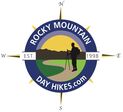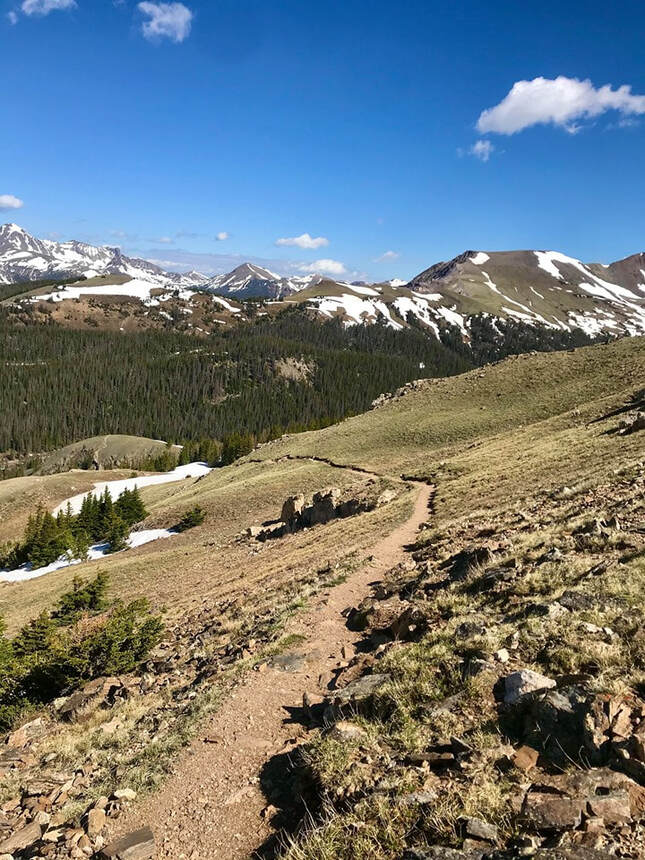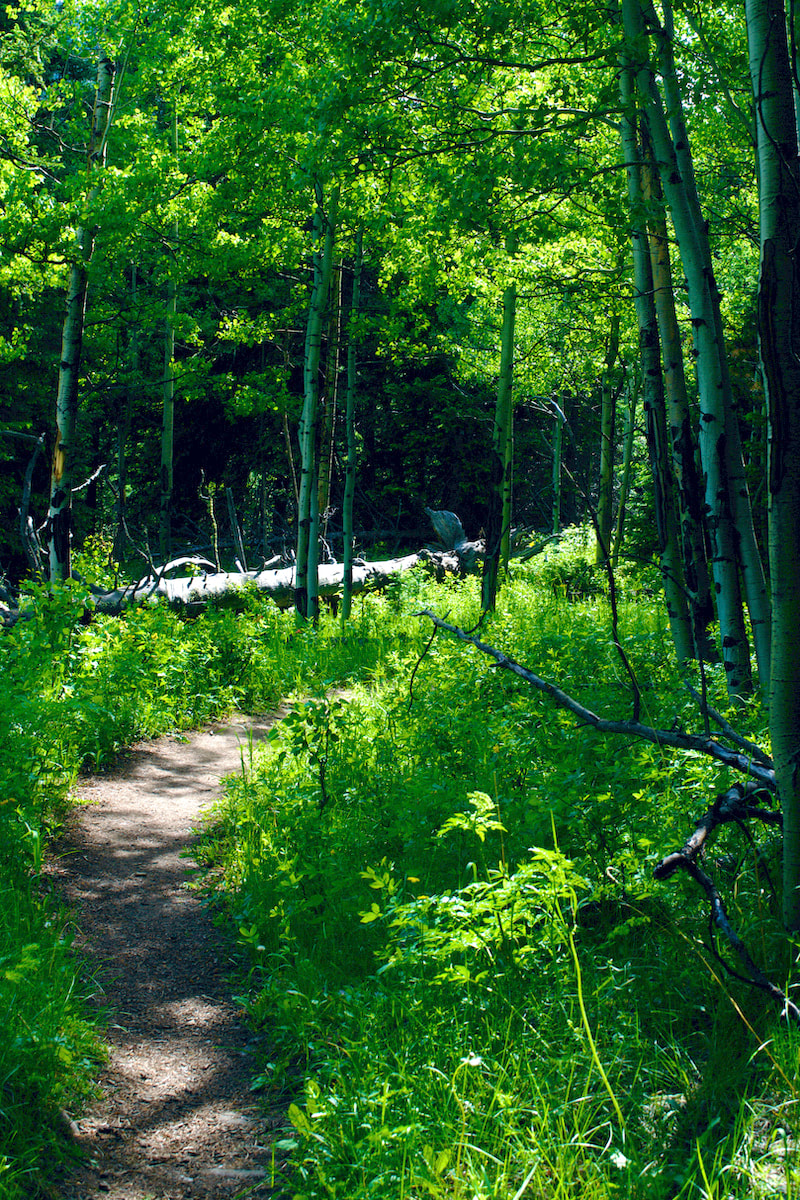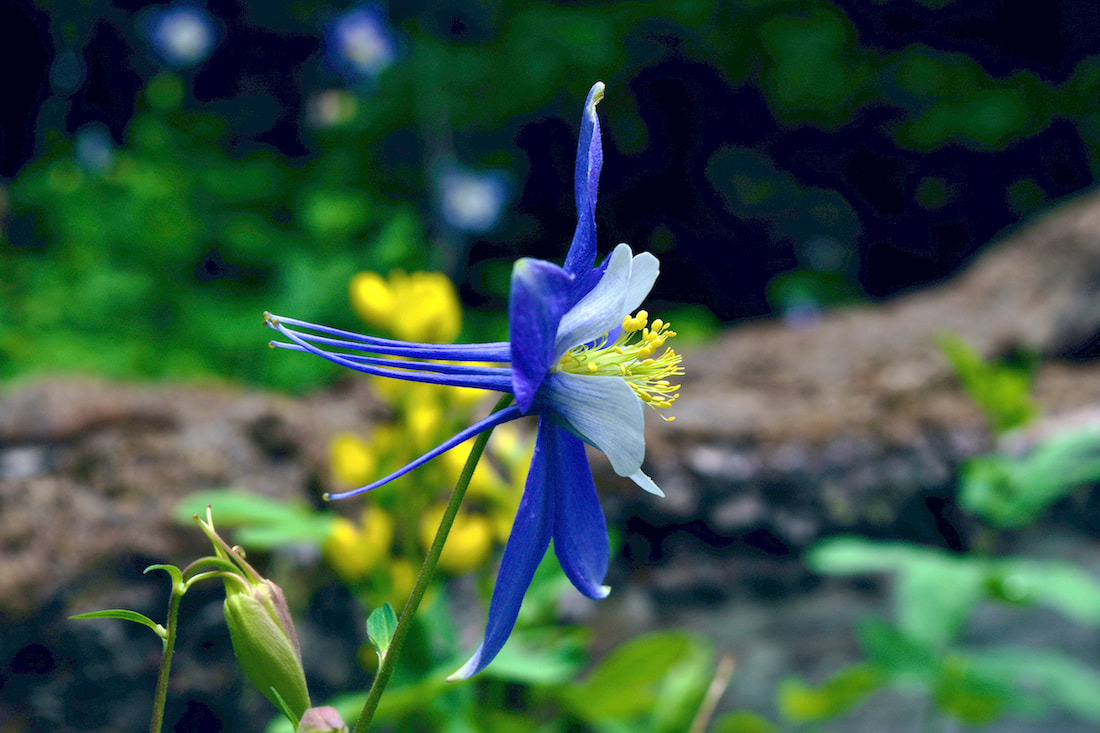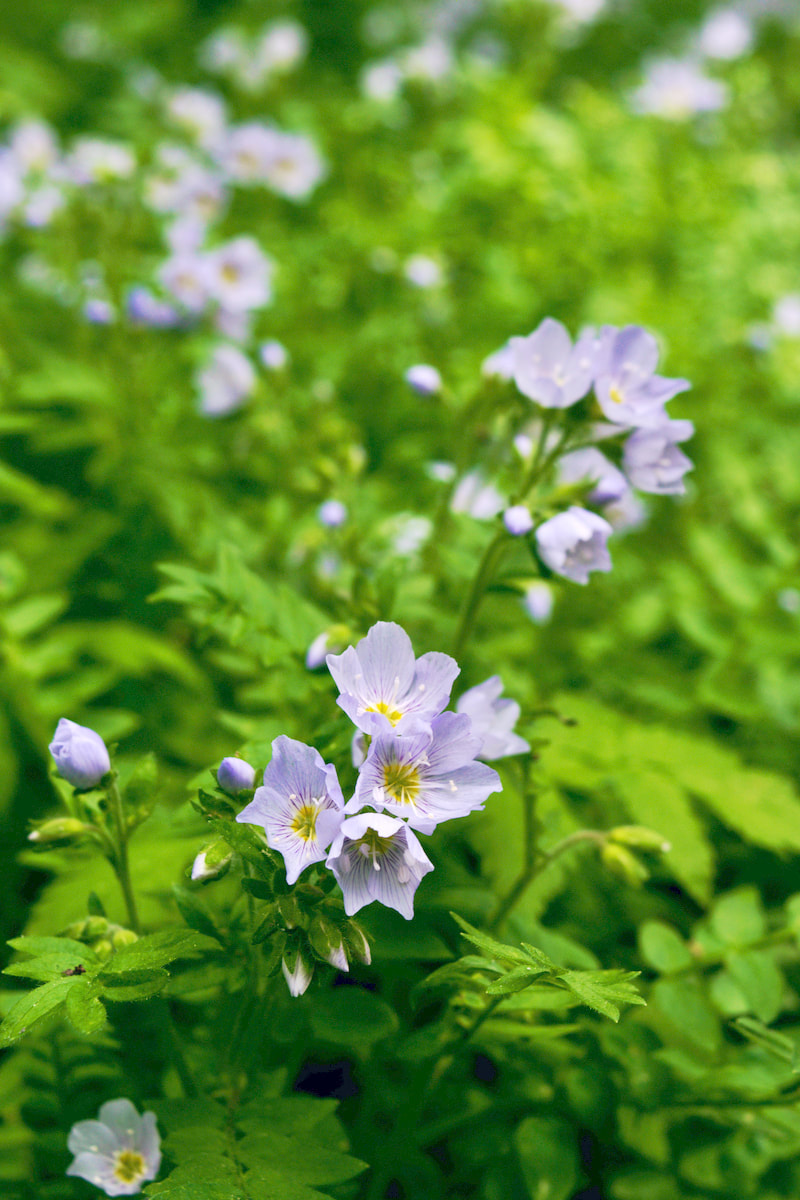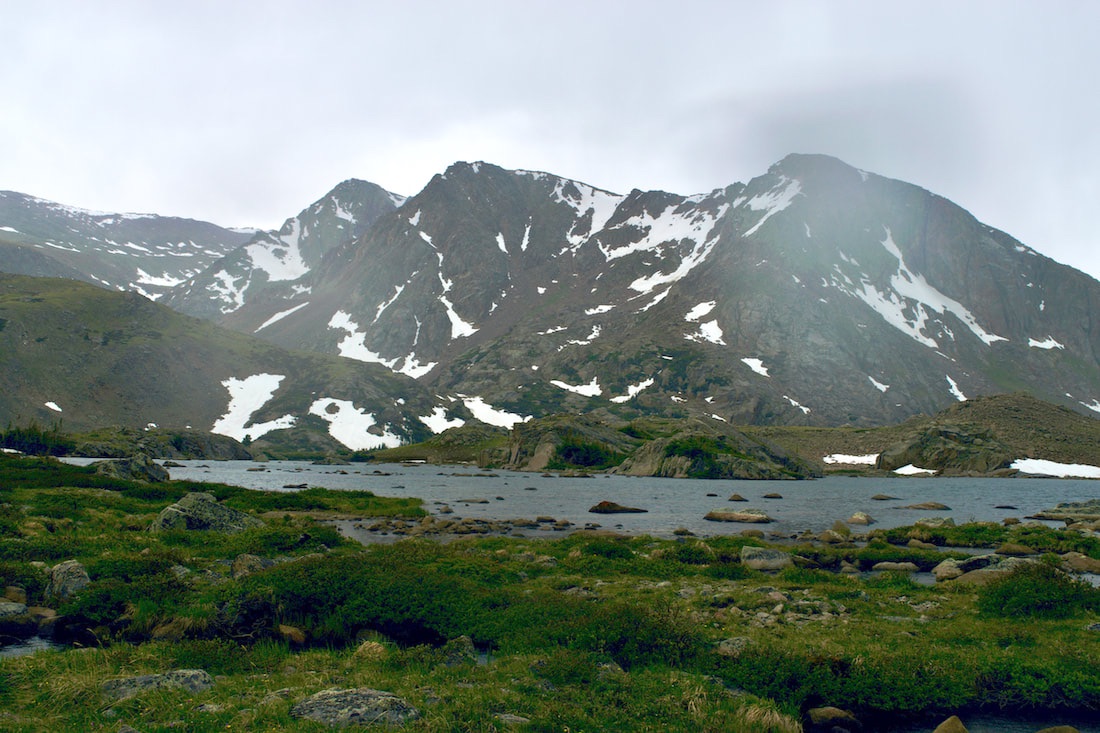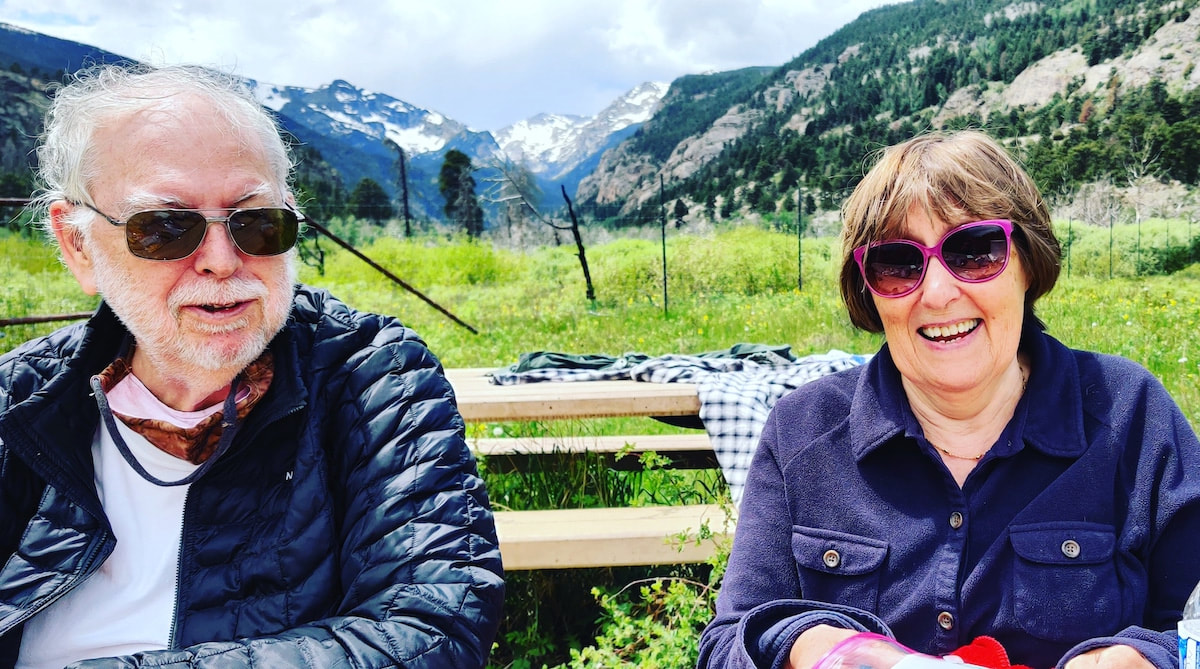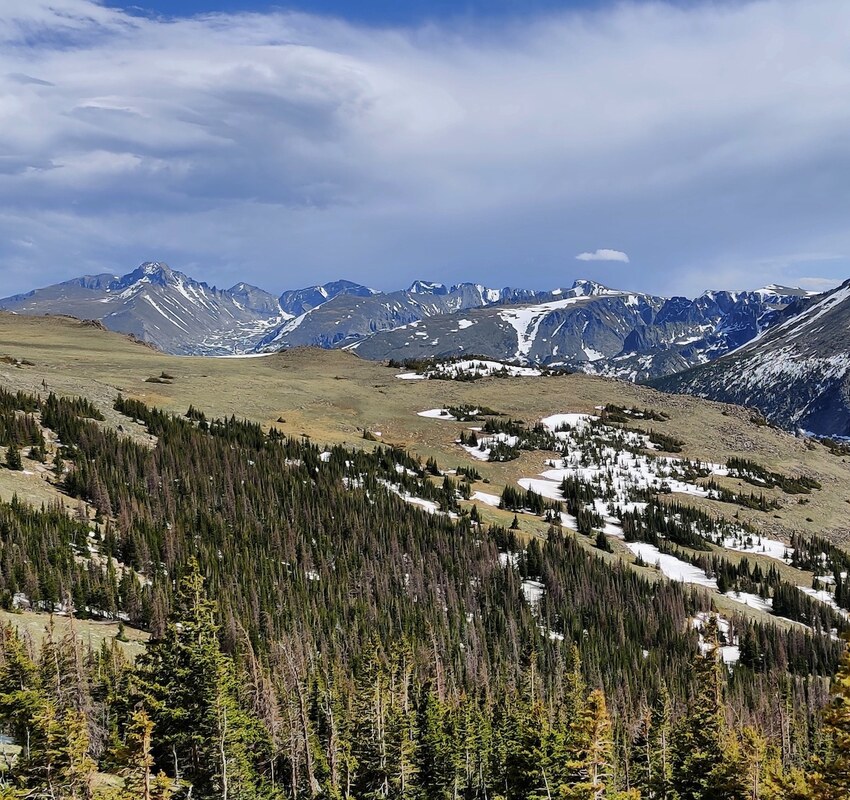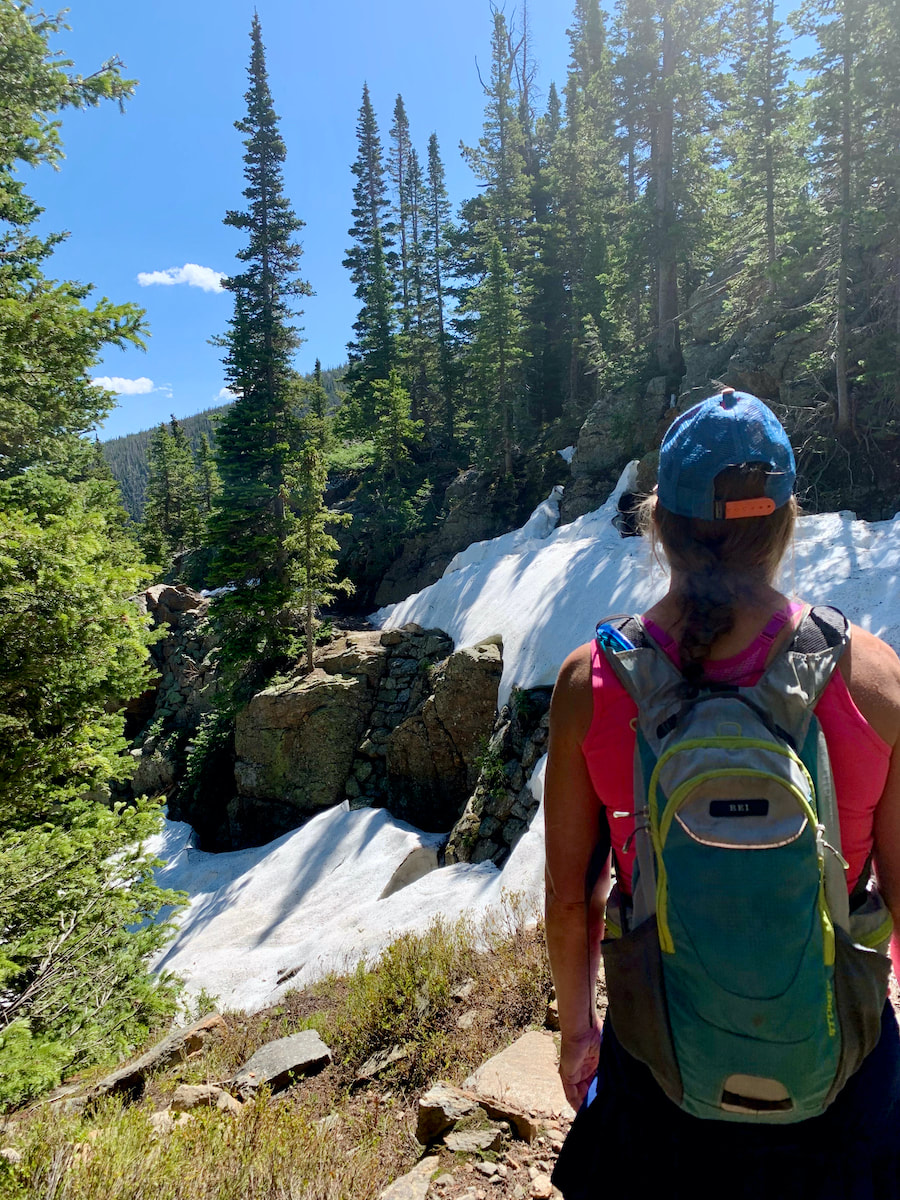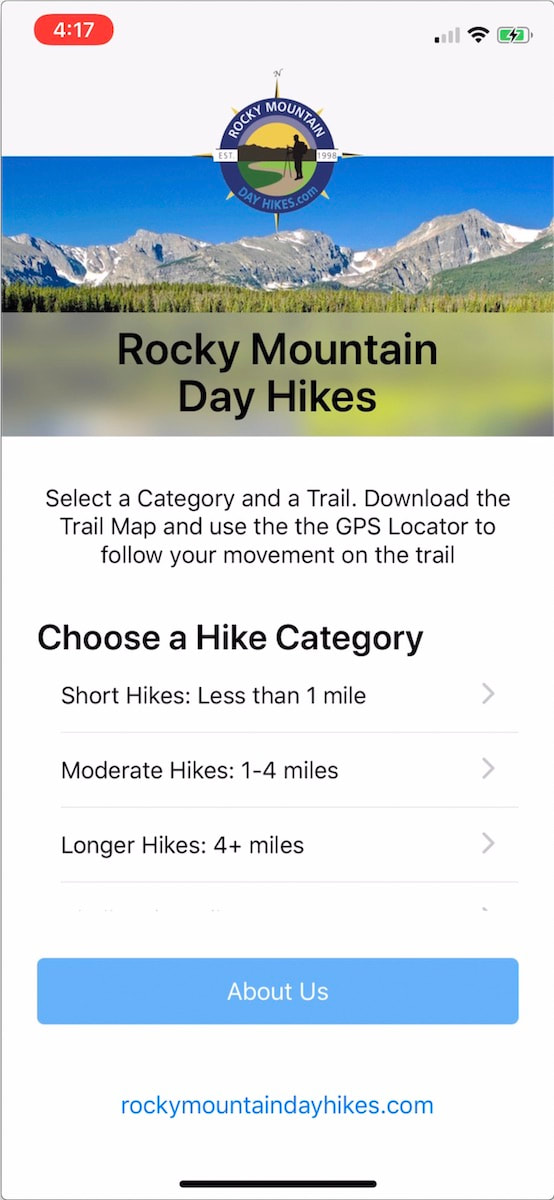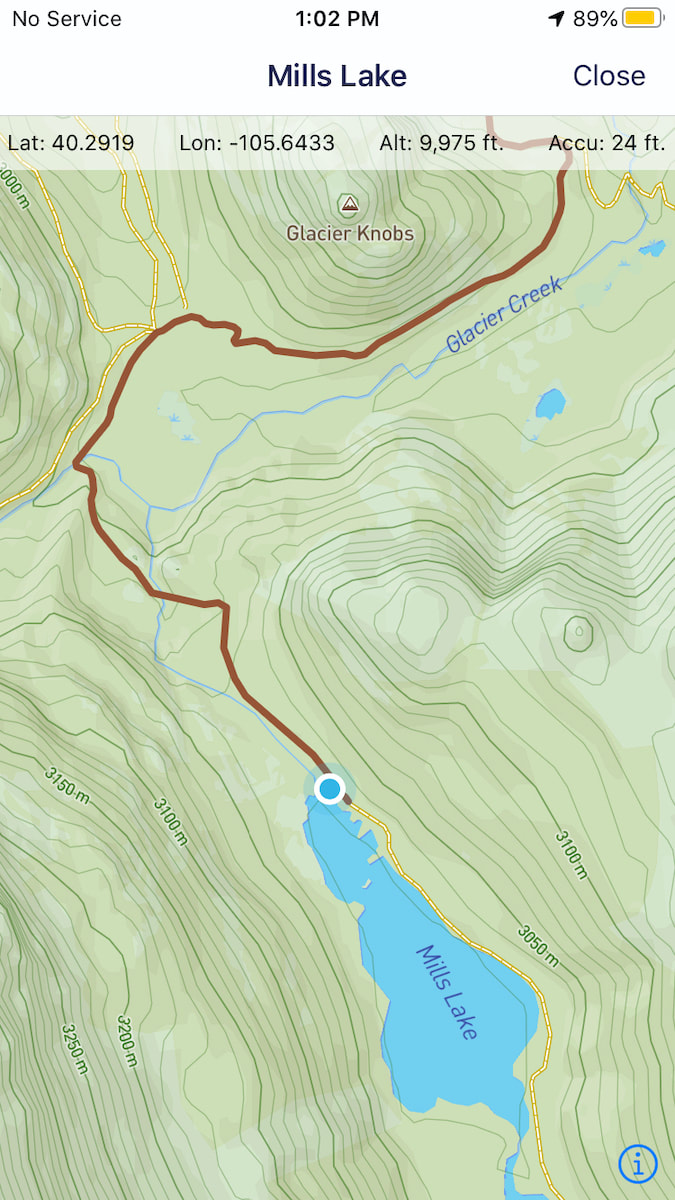|
Notes from the
Trail |
|
Story by Barb Boyer Buck Photos by Simon Vogt “The summit is the goal, but it’s not the reason.” For Simon Vogt, mountaineering in the high peaks of Colorado’s Rocky Mountains has become a metaphor for the new life he is developing for himself: one of sobriety and focus. Simon has attempted to climb Longs Peak twice – once in November of last year and then again in April of this year. The most recent trek to Longs ended at the intersection of trails leading to Chasm Lake and Boulder Field. “I knew that I was being very ambitious trying to climb Longs at that time,” he explained. “It was winter time, I was alone, and I hadn’t done anything that big in terms of altitude and class. “I set out, all prepared and with every intention to summit. I didn’t get very far, only 4-5 miles in, when I reevaluated the time it took me to get there, the time I still had ahead of me, the weather, and the time of day. I decided I’d gone far enough & turned around there.” This thoughtful attitude hasn’t been Simon’s strategy his entire life, however. He was born and lived in Germany for eight years after which his family moved to New York. He moved to Colorado for college in the early-1990s. “Colorado is the first place I developed a real interaction with the outdoor world – climbing, hiking & mountain biking,” he said. But he also encountered tumultuous problems with the law, alcohol and drugs. His naturally impulsive and reckless nature got him into some real trouble while he was using and drinking. “I almost died many times,” he said citing a week-long coma from a heroin overdose in 1994 and daring mishaps while bouldering with friends. “I was also shot at several times and stabbed as a result of poor choices,” he said. “It was the world I was living in at the time.” Simon moved back to Colorado about four years ago and a couple of years after that, he almost died again. “I quit drinking after I went to the emergency room for pancreatitis. That felt very deathbed-like,” he said. This was a little more than 18 months ago, in September, 2018. “Being able to get up from that bed and walk out of the hospital was the beginning of a new start, and a miracle.” He faced an immediate test right after getting sober: his boss died, he got evicted from his apartment, and his girlfriend left him. He started living in his truck. In these uncertain days, Simon started taking walks at night because he couldn’t sleep. “I got back into hiking more and more after that,” he said. In the past year, Simon has climbed 17 of Colorado’s 14ers and many other slightly-lower summits. His favorite summit in Rocky Mountain National Park (so far) is Mount Ida, about a 9-mile roundtrip trek that begins at Milner Pass, off Trail Ridge Road. On June 7, he got to the trailhead about 7:30 a.m. and immediately encountered a snow-covered trail. “I put on my nanospikes but right away I got lost,” he said. “It probably took me about two hours to get to treeline, (twice the time it usually takes).” Once he got to the tundra, the trail runs along the Continental Divide. “It was a perfect day, sunny and sometimes partly cloudy. After treeline the trail is dry and well-tread, you can see the path stretch out for about a mile at a time. It’s really gentle and travels up to 12,000 feet,” he explained. From this path, Simon could see features from both sides of the Divide including Rock Cut, Trail Ridge Road, the Alpine Visitor’s Center, the Never Summer Range, Lake Granby, and Longs Peak. I summited at noon and the first time I saw anyone else was on the way back down, about a mile from the summit. It’s nice to be alone, but running into someone is reassuring. It’s a secret link between you and them, a comradery of being with someone within a 10 miles radius. “ Simon generally hikes alone, especially on his longer adventures. “Mountaineering is very peaceful, meditative, and an inner experience,” he said. “There’s a dichotomy between being deep inside of yourself, examining your consciousness from a little further back in your mind, juxtaposed with the physical challenges of the outside environment. “Emotionally it puts me very much at ease, I go out there for the feeling of solitude, to get more of an inner connection by having that outward experience. This is when I thrive and feel alive.” On these treks, Simon also finds he can communicate quite easily with what he understands as God; this has been one of his touchstones since achieving sobriety. “Turning your life over to a higher power, trusting that things are going to be OK, any way it turns out-- that is the key,” he said. “You have to let things go and not stress or be anxious about things you don’t have any control over, like trail conditions or the weather, or what you encounter at work.” “Once you see yourself as connected to a greater path in life it’s easier to enjoy the moment.” The gratitude he feels while on these trips reinforces this connection. Suddenly, he is no longer the outcast and trying to fit himself into a shape society asks him to fill. These days, Simon works as a freelance contractor and carves out considerable time for traveling and mountaineering. While standing on these mountaintops alone, he sees these moments as wonderful gifts– that are uniquely for him alone. “I experience a rush of endorphins, that weird chemical euphoria that I used to seek out artificially,” he explained. “I become grateful for being a human on this planet, for having legs to get me to the summit.” Simon is continuously honing his preparation for hiking, after every trip he has figured out a way to lighten his pack a bit more and reduce the amount of water he carries. His advice for hiking is similar to his advice for achieving and maintain sobriety. “When climbing a mountain, you should only expend about ¾ of your energy climbing to the summit, you need to reserve about ¼ for the return,” he counseled. “You need to find your own path and whatever path that is, keep moving. Keep moving even if it’s not forward, sometimes you have to go sideways. As long as you keep going – take another step and then another and another. “I apply the same things in hiking that I apply in recovery; it’s not necessarily getting to the mountain top that’s the important thing. In life, you’re never like ‘I made it!’ You never truly reach that point. You’re never done, it’s never over. Once you get to the top you have to get back down.” Taking responsibility for his actions, along with expecting setbacks on the journey is essential to Simon’s new outlook on life. “If you can use those setbacks and disappointments not as a discouragement but as a motivator, you succeed,” he said. “They are learning experiences and that’s what it takes to improve. You have to expect to have problems and run into unforeseen things – in life and in hiking.”
0 Comments
For a brief moment, spring rises through our elevation on its way up to the alpine. The aspens leaf out with a spring green and and the meadows show a flush of new green growth. Golden banner and blue flag iris are among the early season flowers that let us know summer is near. The waterfalls flow heavy with snowmelt and we wait for the snow to clear off the trails so we can hike to the alpine lakes.
What’s it going to take to get to the trailhead in Rocky Mountain National Park? A little advance planning and some patience. Rocky Mountain National Park has so many fantastic hiking trails that are very popular. Over the years, getting to these trails have become increasingly more difficult with increased visitation. The line of cars to get into the Park are longer and finding parking often involves using shuttle busses. And even then, sometimes the parking spaces are just used up!
Park officials have tried to respond. It’s now possible to Park your car east of the Town of Estes and catch the Hiker Shuttle that heads you straight into the Park. But, there’s still more work to be done. It would be great if there was a dedicated lane for the shuttle busses to pass the long line of cars waiting to go through the entrance gates, for example. This year, in response to coronavirus concerns, the Park is trying out a reservation system to limit the number of cars entering the Park and spreading the people congestion throughout the day. Last Sunday, I got to try it out. My hiking partner and I decided we would get a reservation to go into the Park between 8am and 10am. I signed up on recreation.gov the previous week and found plenty of spaces available. That may change as people begin to learn about the reservation system.
and once we reached the entrance gate, we flowed though pretty quickly. They wanted to see my reservation and my Park Pass. Our next decision was about whether we should take our chances with trailhead parking or just go straight to the Park-and-Ride lot and take the shuttle, like we ended up doing last week. Just as we were contemplating that question, a flashing road sign notified us the the Bear Lake parking lot was full and to use the Park-and-Ride. Decision made.
risk these days. We were all outside and the masks kind of helped us feel protected. I got a little tickle up my nose and wanted to sneeze. That might bring on some social distancing! I suppressed my sneeze.
The Park is currently running five shuttle busses between the Park-and-Ride and the Bear Lake parking lot. It takes a bus about 30 min to make the round trip. In order to keep people safe while riding the bus, they’re only allowing about 15-20 people on a bus. People were patient while they waited. It looked like the 4th and 5th shuttle bus didn’t come on line until 9:30, so that may have delayed out time. It took us a little over an hour to finally get to the trail head. 10,000ft. If you are hiking one of the trails originating from the Bear Lake area, that’s about the elevation where you will run into snow, including the trail to Dream Lake, Lake Haiyaha, or the Flattop trial, which also connects to the trail to Odessa Lk. These snow obstacles can be slippery and fun, or slick and treacherous. And sometimes, the winter packed snow trails can lead you off the summer trail. That can make travel even more difficult. Last week, my hiking partner and I headed up the flattop trail. We were not sure what the snow situation would be like, but we decided to find out.
My hiking partner brought his micro spikes and he was glad he had. I assumed the snow would be packed but soft enough without, which worked fine for me. Of course, a group of young women past us in their sneakers and that got me thinking about snow tires. Because the rubber of winter snow tires are designed to stay soft in colder temperature, they are able to grip the road better. I wondered if the same idea applied to sneakers. Trail musings.
A snack stop at the Dream Lake overlook would have to mark our accomplishment for that day. It was a gorgeous day and we lingered taking in the awesome view and mountain air. We were joined by a Clark’s Nutcracker who also was enjoying the day.
The More Things Change, the More They Stay the SameBy Barb Boyer Buck “What’s on your butt and why are you going to Cleveland?” I looked over at my dad who was sitting next to me while I was driving. I had no idea what he was talking about.
“Barb! The speed limit is 45!” he said. Oops, I was going 50. I was excited about driving up above treeline on Trail Ridge Road and wasn’t paying close attention. Also, for the first time in decades, it was a beautiful, early June afternoon and the traffic was sparse. I was giddy about this – it had been more than 20 years since I’ve seen visitation this light in Rocky on a glorious summer day. I was driving his car, so I respected his wishes and slowed to 45 mph. Almost immediately, a large truck was tail-gaiting me. “See, now there’s a bozo on my butt since I’m going the speed limit!” I said, but Don heard differently. All three of us broke out in uproarious laughter when I explained to my dad that what he heard as Cleveland was “speed limit” and nothing was wrong with my butt. One of the things I love most about my parents is their senses of humor. When RMNP announced the timed-entry reservation system would start on June 4, I made a reservation for the first day. It is required to present your receipt (paper copy or downloaded onto your phone) at the entrance gate and that you enter during the time period you reserved. I told my parents my reservation was from 8-10 a.m. and asked they pick me up by 8.
Note to self: next time, tell them to be someplace one hour before I really need them there. There were rangers standing on the road, right before we reached the Beaver Meadows entrance of RMNP at about 9 a.m. to make sure we had made a reservation and then at the gate we showed rangers our reservation confirmation. My dad had a heart attack three years ago; he turned 78 this year. Sprague Lake was the perfect spot, I thought, for a small hike. We took a slight detour to show them the handicapped accessible camping spot. There is virtually no elevation gain and it’s a half-mile jaunt around the perimeter of this lake, which was created by Abner Sprague when he was building is lodge there in 1914. To my surprise, my parents had never been there. Our family moved to Colorado Springs in 1979 and my parents owned a house in Longmont for 30 years before they downsized to a smaller place in Johnstown, just two years ago. I had hiked with my parents in Rocky many times before; I guess we were all younger then and did more strenuous hikes.
While preparing for this trip, I had suggested to my dad that he bring his pole & flies. “I don’t have a current fishing license,” he said. What? I had envisioned Mom & I hiking while my dad fished – that’s what we had always done in the past while us kids were growing up, on the South Platte River at Deckers, in southern Colorado. But that was 40 years ago, I reminded myself. My mother was having a wonderful time – she loved discovering the different wildflowers and encouraged me to take close-up shots of everything. “That one is called Frauenschue,” she said, pointing at a golden banner. My mother is German and grew up in a small town in Bavaria, exploring the woods and hills of Ober Franken. Frauenschue translates to “women’s slippers.” “Oh, I think that’s a wild hazelnut bush!” she exclaimed. “After the war (WWII), my mother sent us kids out to the woods to pick them. We ate a few (they were so sweet!), but kept most of them because she would grind them up to make flour and cookies.” Hermine pointed out wild strawberries and gooseberries as well. She stopped to marvel at the striated granite rocks and pieces of wood with interesting markings from insect infestation. I think I get my excitement at seeing beautiful nature from my mother, who notices every detail. She doesn’t hide her enthusiasm when she is pointing these things out, and it’s an absolute joy to be with her in nature (unless she starts talking too loud to my dad, which can scare off the wildlife.)
“How can I take pictures if I have those in both hands?” he said. I pointed out the loops attached the handles. “You just let go of your poles & take a picture,” I explained. He finally agreed and was soon out-pacing my mother and I, who stopped often to admire the flora and features around us. So, we hiked up there. Again, my father was outpacing my mom and I who were discovering more plants and flowers. On the way down we got caught in a sudden rainstorm and were pelted, somewhat painfully, with hail.
Note to self: patience is the key when dealing with children and elderly parents. Our drive up to the top of Trail Ridge Road was everything I hoped it would be. On that day, it was very warm and the snow that had been recently plowed through to open the pass was melting quickly, rivulets of snowmelt were everywhere. But Mom & Pop were too tired to take the trip all the way down to Grand Lake, so we turned around and drove back down to Estes Park.
beach, or the redwood forests, or vacationing in Yosemite National Park. In Colorado, you guys were older but we still went fishing and hiking all day. “What I liked was we also saw a lot of young families with their small children, instilling in them the love of nature. We saw people our age still hiking, even if they needed polls or sticks.” My skeptical and stubborn dad had a great time, too. “I was reluctant to go, having been almost exclusively in my house for about 100 days, but the park has been a favorite destination since I moved to Northern Colorado in 1988,” said Don. “We go two to five times a year on average and every trip before was enjoyable.“This time, with the Covid-19 around, I was not sure I wanted to be around people that much and the park has always been full in the past with heavy car and foot traffic. But I went because, 1. There were reservations to minimize attendance, 2. This is the best time to see the park emerging from its delayed winter, and 3. My daughter is a very persistent person, and enjoyable company.” Note to self: remember everyone, no matter what their age, have irritating quirks and differences in approach to life, including me. Both of my parents agreed the air was cleaner, the visibility was greater. “The whole park looks refreshed, like the pandemic gave it a breather,” said my mom. “Trail Ridge Road was always a special place for me,” she said. “It always showed me how unimportant we as humans are, even if we think we are so important. In other words, the park put me back to reality.” “The problem with the timed arrivals is that there are no timed departures,” Don said. “We, like I imagine most other visitors, decided that once we arrived, we were going to stay as long as possible. The result is, of course, that the further in the day, the more crowded the park became. “The air was crystal clear, even though we were breathing it through masks, a practice that about half the visitors seem to employ. The clarity of the air allowed us to see and photo extremely detailed features on the far horizon,” he said. It was a wonderful day for many reasons. I enjoyed reconnecting with my parents and reminiscing about the times we hiked as a family over the years. My mother experienced the burgeoning wildflowers and plants that she enjoyed so much. And my grumpy old dad got a little less grumpy. “Returning home, we felt that peaceful defusing of nerves that had started on entering the park and continued well into the night,” he said. “I realized that I needed that trip. I have three months of tension to get rid of, and Rocky Mountain National Park had once again worked its wonders.” With the reopening of Rocky Mountain National Park, things have begun to feel a bit more 'normal' for visitors and residents of Estes Park. I recently enjoyed early morning hikes to Estes Cone, Chasm Lake and Mount Lady Washington. The trails were almost completely dry and uncrowded. Upon return to the Longs Peak Trailhead post-hike, the parking lot was about one quarter full on the days that I visited.
On Friday, June 5, I completed the Bear Lake to Fern Lake Shuttle hike. The experience was quite different from years past for many reasons. Three of us girls made reservations for two cars and met at the Beaver Meadows Visitor Center at 6:30 a.m., just as law enforcement officers were setting up two emergency vehicles and stopping all cars to make sure folks were aware of reservation requirement. We dropped a car at the Fern Lake Shuttle Stop and took the second car up to the Bear Lake Trailhead. There was plenty of parking at both locations. We encountered snow about one mile into the hike and the trail remained snow-packed until the turnoff for Odessa Lake. There is more snow in Odessa Gorge than I have ever experienced outside of winter. Microspikes are a must as the trail crosses several snow gullies. I worked hard to kick in deep steps and my sneakers got absolutely soaked. For those unfamiliar with steep snow travel, these crossings will likely be scary and dangerous. A lightweight ice axe would be a good idea for added security. We saw few people on this section of the trail: a group of campers at the Sourdough site who warned us about the treacherous snow and a solo female hiker who had come up from Fern Lake. The views of Grace Falls, Notchtop Mountain and the Little Matterhorn were especially stunning after such a long hiatus from hiking in RMNP.
We were two of three people on the small shuttle to Park and Ride, but there was quite a wait to board the larger shuttle to Bear Lake. Eighteen people are allowed on each shuttle to provide for social distancing. Almost everyone at the Park and Ride wore face coverings. It was the largest group of people I had been around in quite some time. The sign on Bear Lake Road just before Park and Ride reported that Bear Lake Parking was full, which likely contributed to the crowds on the shuttle system. Upon arrival, we noted that the Bear Lake parking lot was about two-thirds full. It took an hour total to get from Fern Lake Shuttle Stop to Bear Lake via the shuttle system at 1:00 in the afternoon on a Friday. I would highly recommend hiking to The Pool, Fern Falls and Fern Lake from the Fern Lake Trailhead. I would suggest waiting a few weeks to attempt the Bear Lake to Fern Lake shuttle hike unless all participants are well-versed in snow travel. Policies, rules, and closures are changing as quickly as trail conditions. I hope we can all continue to be kind and patient, especially to our hard-working National Park employees. For the latest updates, visit Current Conditions - Rocky Mountain National Park (U.S. National Park Service). Reservations to enter Rocky Mountain National Park can be made at Recreation.gov. by Marlene Borneman The fossil record indicates that orchids may have coexisted with dinosaurs! The orchid family is the largest family of flowering plants in the world, approximately 30,000 species. So, it is only fair that approximately 26 species get to call Colorado home. Colorado’s native orchids are terrestrial orchids, referring to growing from the ground in soil. They range from a few inches to over a foot high. Since Rocky Mountain National Park is my backyard, I’m only going to tell the story of orchids that grow in the Park and the Front Range.
I also find how they grow mind-boggling! I will attempt to keep this simple, but remember native orchids are anything but simple! Orchid seeds are extremely minute and can number into the thousands in one single capsule. Because orchid seeds are so minute, they have no food reserves to germinate and are totally dependent on fungus for nutrients during the early stages of growth. Native orchids need a relationship with a variety of fungi to germinate and grow, for some orchids through maturity.
Blunt-leaf Orchid is uncommon in RMNP. It is another orchid I have only seen on the west side. 3”-9” high with one leaf at the base of the plant. The flowers are small and white-greenish in color.
A little trivia …What orchid has the most economic use today? The vanilla orchid. Of course, it does not grow in Colorado! However, some wild orchids found in the Rockies were once used as a food source or for medicinal purposes. For example, the bulbs (corm) of fairy slipper orchids were cooked by Native Americans for their rich buttery taste. The Paiutes made tea from the dried stems of coralroot orchids which was thought to build up the blood. Yes, believe it or not, there are folks out there who read flower guidebooks/websites and social media to locate native wild orchids to dig up in an attempt to transplant. For this reason, the location of orchids should never be made public. It is a rite of passage for anyone truly dedicated to observing and preserving native orchids to search habitats on their own and earn finding orchids. Only nature knows where to “plant” these orchids for success, so don’t even think of transplanting. Appreciate the orchids when you find them and let others enjoy their magical beauty, too. I just take a bazillion photos. My intention is not only to amplify your curiosity but also your respect for these vulnerable plants. Protect them. Suggested reading: The Orchid Thief by Susan Orlean Those Elusive Native Orchids of Colorado by Scott F. Smith Did the Park survive without us? Yes it did. Rocky Mountain National Park reopened just over a week ago after being closed for about two months due to corona virus concerns. When I first drove into The Park on the eve of that opening day, it was like returning to a familiar place that I had not visited in a while, like returning home. I looked around to see if anything had changed, but everything was still as it was before, excepting that the aspens were leafing and Moraine Park was greening.
It was a beautiful evening at Bear Lake. I also did a quick jaunt up to Alberta Falls, and then caught a beautiful sunset at Sprague Lake. Not a bad reintroduction.
I, for one, am happy that they are limiting the number of cars entering the Park and spreading the traffic throughout the day. But, it will be different and it will take some getting used to. The lines of cars going into the Park on this morning was not long and it was difficult to gauge how full the parking lots at the trailheads might be this late in the morning. I decided to find out. First I went to the Glacier Gorge parking lot where our trailhead for Mills Lake was, but not surprisingly, the small parking lot was completely full. We drove up to Bear Lake to see if there was anything in this bigger lot, but they were turning people around, that lot was also full. So, we headed back down to the Park-and-Ride Lot. A fruitless effort that probably cost us 20-30 min.
It did not take us long to get to our destination, it would have been better if we had just committed to using the shuttle in the first place. We were the only ones to de-bus at the Glacier Gorge Trailhead, everybody else was heading up to Bear Lake. We left our masks on thinking that the trailhead might be crowded, but a Park volunteer and another couple were the only ones there. I didn’t check, but I believe the restrooms were open.
What we found is that most everybody was attempting to keep a physical distance when passing on the trail. Many did have some sort of neck gator or bandana around the neck and were prepared to raise them as a mask, although most did not do that, and we quickly followed the practice feeling comfortable in our setting. We did occasionally encounter those that did raise their mask as they approached us and, in that case, we did also. It felt more like like a friendly gesture in passing. It reminded me of the movie A Knights Tale when two jousters preparing to joust with their protective head gear on would lift their lances in a friendly exchange as the past each other.
National Park mask ($9.99, $8.49 for members). Wearing that mask would be a way to stay safe and look good, while also supporting Rocky! The trail to Alberta Falls was covered by some snow, but it was easy enough to divert around and I can imagine most of that snow is gone by now, the snow is melting fast! Alberta Falls was flowing very full with snow melt. But once past Alberta Falls, we encountered more snow on the trail and occasionally we had to pause to let someone cross on the narrow packed snow trails, or they waited for us, everyone making an effort to social distance, or when that wasn't possible, turning away while someone passed. Though it seemed unfriendly, usually the other person said thanks, acknowledging the effort. While we hiked, I was able to try out a new app called GPSMyHike, soon to be released. It’s an app developed by Rocky Mountain Day Hikes and this was the first time I was able to try it out.
It wasn’t until after we passed the trail cutoff for The Loch Vale that we found sections of the trail mostly covered with considerable snow, and the snow was slippery and softening. On one steeper section of the trail, we stepped aside for a mother with a young child on her back in a kid pack while holding the hand of another chid that was slipping down the slope. I commended her on her ability to stay up right! She was followed by an elderly couple that was very glad to have spikes strapped onto their shoes. The husband commented on how glorious it was at the lake with the mountains all around. They were enjoying their day in the mountains.
Finally, we made it to the lake and there were all kinds of terrific large, sunny flat rocks to have a picnic by this spectacular mountain lake. It was great to be back in the Park!!
|
"The wild requires that we learn the terrain, nod to all the plants and animals and birds, ford the streams and cross the ridges, and tell a good story when we get back home." ~ Gary Snyder
Categories
All
“Hiking -I don’t like either the word or the thing. People ought to saunter in the mountains - not hike! Do you know the origin of the word ‘saunter?’ It’s a beautiful word. Away back in the Middle Ages people used to go on pilgrimages to the Holy Land, and when people in the villages through which they passed asked where they were going, they would reply, A la sainte terre,’ ‘To the Holy Land.’ And so they became known as sainte-terre-ers or saunterers. Now these mountains are our Holy Land, and we ought to saunter through them reverently, not ‘hike’ through them.” ~ John Muir |
© Copyright 2025 Barefoot Publications, All Rights Reserved
